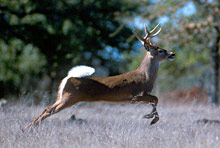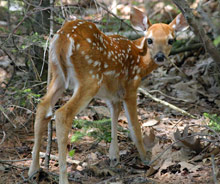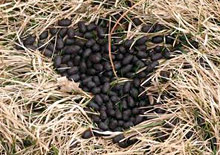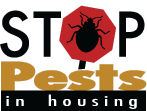- HOME
- » PEST SOLUTIONS
- » Deer
Deer
How to deal with deer
 |
|
White-tailed buck. Photo by Scott Bauer, USDA Agricultural Research Service, Bugwood.org. |
 |
|
White-tailed fawn. Photo by Paul Bolstad, University of Minnesota, Bugwood.org. |
 |
|
Deer scat. Photo by Whitney Cranshaw, Colorado State University, Bugwood.org. |
Dealing with deer can take a community-wide effort. Make sure no one is feeding deer and band together to get roadsides mowed so that deer can be more easily seen from the road. In many places, deer have only one natural predator left—people. Experienced, careful hunters can reduce herds, supplying some food pantries with meat at the same time.
Consider laying deer netting, available at garden centers, over plants; it offers some protection. Or install fences. Deer don’t like to jump into small enclosures; a 4-foot-tall fence works for small gardens. For large gardens or landscape plantings, an 8-foot fence works. Some dogs also deter deer, but make sure you have a dog fence—chasing deer is not allowed. And deer will soon learn if your dog is chained.
What they look like
Their long, slender legs, large ears, and agile brown bodies all say “deer”—but you really know it when you see their tails flip up, showing a fluffy white underside as they bound into the safety of the woods. Deer are smaller than you think—up to 3 ½ feet at the shoulder. Males carry antlers from spring through fall. And fawns, the babies, are spotted. Other signs: in winter, deer droppings look like someone spilled a handful of black jellybeans; in summer, they’re clumped together. Their tracks are cloven, leaving well-worn trails in the woods. Sometimes you’ll find padded-down grass where deer slept for a spell.
Where they live
Deer like to mix their time between fields and the bushy outskirts of forests. But where this isn’t an option they make do with our backyards.
What they do
Deer eat 6 to 8 pounds of plants a day. If this is coming out of your yard or garden, you’ll know it. Where woods are overpopulated with deer, they eat seedling trees—a problem for forest renewal. (Some places are so overpopulated that deer starve in winter.) And some disease-carrying parasites feed on deer.
Beware of deer along roadsides. They’re mostly active at dawn and dusk and go into a trance when they see headlights. Be alert. Where you see one deer, more often follow. Brake carefully and don’t swerve. Oncoming traffic, pedestrians, icy roads—all good reasons to stay your course.
Resources
Dealing with Deer Recorded Webinar
Internet Center for Wildlife Damage Management
See results from the Northeastern IPM Center’s resources database.
